
Interstate 495 (I-495), commonly known as the Long Island Expressway (LIE), is an auxiliary Interstate Highway in the US state of New York. It is jointly maintained by the New York State Department of Transportation (NYSDOT), the New York City Department of Transportation (NYCDOT), MTA Bridges and Tunnels (TBTA), and the Port Authority of New York and New Jersey (PANYNJ).
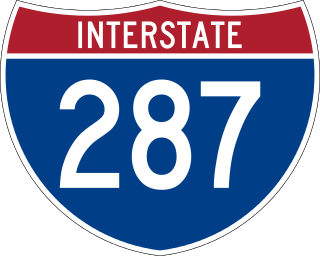
Interstate 287 (I-287) is an auxiliary Interstate Highway in the US states of New Jersey and New York. It is a partial beltway around New York City, serving northern New Jersey and the counties of Rockland and Westchester in New York. I-287, which is signed north–south in New Jersey and east–west in New York, follows a roughly horseshoe-shaped route from the New Jersey Turnpike (I-95) in Edison, New Jersey, clockwise to the New England Thruway (I-95) in Rye, New York, for 98.72 miles (158.87 km). Through New Jersey, I-287 runs west from its southern terminus in Edison through suburban areas. In Bridgewater Township, the freeway takes a more northeasterly course, paralleled by US Route 202 (US 202). The northernmost part of I-287 in New Jersey passes through mountainous surroundings. After crossing into New York at Suffern, I-287 turns east on the New York State Thruway (I-87) and runs through Rockland County. After crossing the Hudson River on the Tappan Zee Bridge, I-287 splits from I-87 near Tarrytown and continues east through Westchester County on the Cross-Westchester Expressway until it reaches the New England Thruway. Within New Jersey, I-287 is maintained by the New Jersey Department of Transportation (NJDOT), and, within New York, it is maintained by the New York State Thruway Authority (NYSTA).

Interstate 295 (I-295) is an auxiliary Interstate Highway within New York City. Measuring 7.7 miles (12.4 km) in length, I-295 originates at Hillside Avenue in Queens, running north across Queens and over the tolled Throgs Neck Bridge, to Bruckner Interchange, a junction with I-95, I-278, I-678, and the Hutchinson River Parkway in the Bronx. From south to north, I-295 intersects the Grand Central Parkway, I-495, and the Cross Island Parkway in Queens before crossing the Throgs Neck Bridge and splitting with I-695. In Queens, I-295 is also known as the Clearview Expressway.

New York State Route 878 (NY 878) is an east-west expressway on Long Island and in New York City. The route exists in two sections, which both form the Nassau Expressway. NY 878's western terminus is the Belt Parkway and Conduit Avenue (NY 27) in Ozone Park, within southern Queens. Its southern terminus is immediately before the Village of Atlantic Beach, at the Atlantic Beach Bridge in Lawrence, within southwestern Nassau County. NY 878 is discontinuous between Farmers Boulevard in Queens and the town of Inwood in Nassau County. The two sections are connected to each other by Rockaway Boulevard and Rockaway Turnpike.

New York State Route 27 (NY 27) is a 120.58-mile (194.05 km) long state highway that runs east–west from Interstate 278 (I-278) in the New York City borough of Brooklyn to Montauk Point State Park on Long Island, New York. Its two most prominent components are Sunrise Highway and Montauk Highway, the latter of which includes the Montauk Point State Parkway. NY 27 acts as the primary east–west highway on southern Long Island east of the interchange with the Heckscher State Parkway in Islip Terrace. The entire route in Suffolk, Nassau, and Queens counties were designated by the New York State Senate as the POW/MIA Memorial Highway. The highway gives access to every town on the South Shore. NY 27 is the easternmost state route in the state of New York.

The Northern State Parkway is a 28.88-mile-long (46.48 km) parkway on Long Island in the U.S. state of New York. The western terminus is at the Queens–Nassau County line, where the parkway continues westward into New York City as the Grand Central Parkway. The eastern terminus is at New York State Route 347 (NY 347) and NY 454 in Hauppauge. The parkway is designated New York State Route 908G (NY 908G), an unsigned reference route. As its name implies, the parkway services communities along the northern half of the island.

Interstate 95 (I-95) is part of the Interstate Highway System and runs from Miami, Florida, to the Canada–United States border near Houlton, Maine. In the US state of New York, I-95 extends 23.50 miles (37.82 km) from the George Washington Bridge in New York City to the Connecticut state line at Port Chester. The George Washington Bridge carries I-95 across the Hudson River from New Jersey into New York City. There, I-95 runs across Upper Manhattan on the Trans-Manhattan Expressway for 0.81 miles (1.30 km) through Washington Heights. It continues east across the Harlem River on the Alexander Hamilton Bridge and onto the Cross Bronx Expressway. In the Bronx, I-95 leaves the Cross Bronx at the Bruckner Interchange, joining the Bruckner Expressway to its end. North of the interchange with Pelham Parkway, it then continues northeast via the New England Thruway out of New York City into Westchester County and to the Connecticut state line, where I-95 continues on the Connecticut Turnpike.
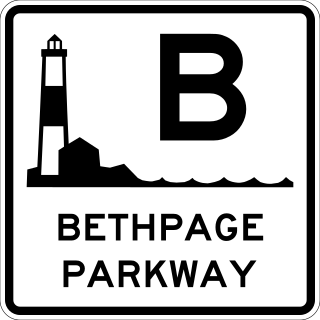
The Bethpage State Parkway is a 2.49-mile (4.01 km) parkway in Nassau County on Long Island, New York, in the United States. It begins at a trumpet interchange with the Southern State Parkway in the village of North Massapequa and serves Boundary Avenue, NY 24, and Central Avenue before terminating at a traffic circle with Plainview Road and a local park road in Bethpage State Park. The parkway is designated as New York State Route 907E (NY 907E), an unsigned reference route. It is also ceremoniously designated as the Philip B. Healey Memorial Parkway for Assemblyman Philip B. Healey (1921–1996).
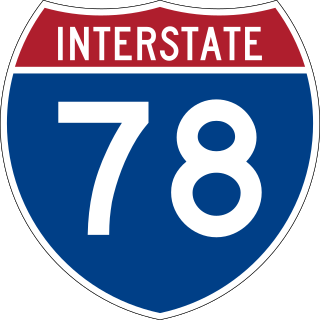
Interstate 78 (I-78) is a part of the Interstate Highway System that runs from Union Township, Lebanon County, Pennsylvania, to New York City. In the US state of New York, I-78 extends 0.5 miles (0.80 km). The entirety of I-78 consists of the Holland Tunnel, which crosses under the Hudson River from New Jersey and ends at an exit rotary in Lower Manhattan. The tunnel and its approaches are maintained by the Port Authority of New York and New Jersey (PANYNJ).

New York State Route 24 (NY 24) is a 30.84-mile-long (49.63 km) east–west state highway on Long Island in the U.S. state of New York. The highway is split into two segments, with the longer and westernmost of the two extending 18.68 miles (30.06 km) from an interchange with Interstate 295 and NY 25 in the Queens Village section of the New York City borough of Queens to an intersection with NY 110 in East Farmingdale in the Suffolk County town of Babylon. The shorter eastern section, located in eastern Suffolk County, extends 12.16 miles (19.57 km) from an interchange with I-495 in Calverton to an intersection with County Route 80 (CR 80) in Hampton Bays.
Playland Parkway is a 1.20-mile (1.93 km) four-lane parkway in Westchester County, New York, in the United States, and is assigned County Route 152. The short stretch of four-lane road connects Interstate 95 and U.S. Route 1 (US 1) with the Playland amusement park in Rye.

New York State Route 107 (NY 107) is a 17.07-mile (27.47 km) state highway in Nassau County, New York, in the United States. The route begins at an intersection with Merrick Road in Massapequa, serving several communities in the town of Oyster Bay before entering the city of Glen Cove and terminating at an intersection with Pulaski Street. From here, the right-of-way continues west for a short distance as Pratt Boulevard (CR 243) to Brewster Street and Glen Cove Avenue. Route 107 is the only State Highway on Long Island to enter a city other than New York City. The route connects with several major parkways and expressways and has a concurrency with NY 106 through Hicksville and Jericho Gardens.

U.S. Route 1 (US 1) is a part of the U.S. Highway System that extends from Key West, Florida, to the Canada–United States border at Fort Kent, Maine. In the U.S. state of New York, US 1 extends 21.54 miles (34.67 km) from the George Washington Bridge in Manhattan to the Connecticut state line at Port Chester. It closely parallels Interstate 95 (I-95) for much of its course and does not serve as a major trunk road within the state. It is not concurrent with any other highways besides I-95 and (briefly) US 9, and few other state highways intersect it.
Glen Cove Road is a major, 11.7-mile-long (18.8 km) north–south thoroughfare running through north-central Nassau County on Long Island, New York, in the United States.

The Sound Shore Parkway was a formerly proposed parkway intended to run primarily across the North Shore of Long Island between the City of Glen Cove and the Town of Smithtown, in New York. Like Ocean Parkway on the South Shore, and Lake Ontario State Parkway in Upstate New York, it was meant to provide both recreational use and a seaview, in this case a view of the Long Island Sound. The parkway was to include two new state parks in Lattingtown and Eatons Neck.

Nearly every major type of transportation serves Long Island, including three major airports, railroads and subways, and several major highways. The New York City Subway only serves the New York City boroughs of Brooklyn and Queens. There are historic and modern bridges, recreational and commuter trails, and ferries, that connect the boroughs of Queens and Brooklyn to Manhattan, the south shore with Fire Island and Long Island's north shore and east end with the state of Connecticut.
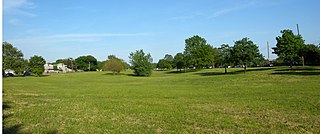
Conduit Avenue is an arterial road in New York City, the vast majority of which is in Queens. The divided highway runs from Atlantic Avenue in Cypress Hills, Brooklyn to Hook Creek Boulevard in Rosedale, Queens at the Nassau County border. The thoroughfare is named after an aqueduct in its right-of-way.
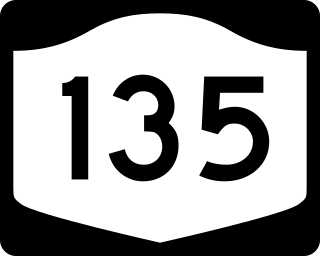
New York State Route 135 (NY 135) is a 10.8-mile (17.4 km) state highway in eastern Nassau County, New York, in the United States. The route is a freeway that connects Seaford with Syosset. The highway runs from Merrick Road in Seaford to NY 25 in Syosset. In between, NY 135 passes through Bethpage and Plainview and serves Bethpage State Park. The highway is ceremoniously designated as the Ralph J. Marino Expressway; however, it is more commonly known as the Seaford–Oyster Bay Expressway.



















